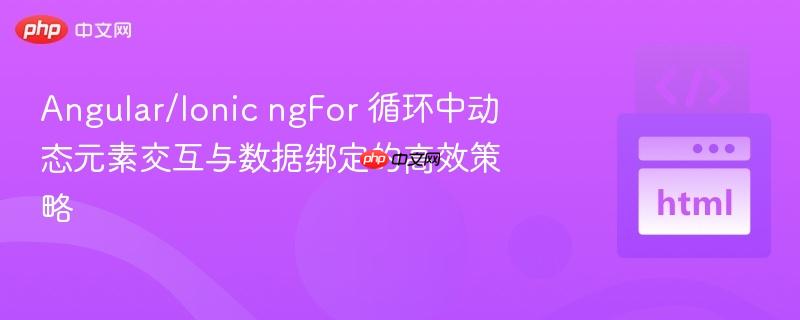
在ngfor循环中,为每个迭代项生成具有唯一id的元素并捕获其值,尤其是在一个元素的事件中需要引用同迭代中另一个元素的值时,常常会遇到困难。例如,在一个ion-row内部,当一个ion-checkbox被点击时,需要获取同行的ion-input的当前值。直接在事件绑定中使用插值表达式(如[{{'cant_'+i}}].value)是无效的,因为angular的模板语法不允许在事件绑定内部进行此类动态属性访问。
为了解决这一问题,Angular提供了多种机制,使得在ngFor的上下文环境中,能够安全且高效地管理元素引用和数据。
模板引用变量是Angular中一种强大且推荐的方式,用于直接在模板中获取DOM元素或组件实例的引用。在ngFor循环中,为每个动态生成的元素赋予一个模板引用变量,Angular会确保该变量在每个迭代中都指向正确的、唯一的元素实例。
假设我们有一个输入框和一个复选框在同一行中,当复选框被点击时,需要获取输入框的值。
<ion-row *ngFor="let item of lines; let i= index" [value]="item">
<ion-col>
<ion-row>
<ion-col size="3" class="centered">
<ion-item class="ion-no-padding">
<!-- 定义模板引用变量 #cantID -->
<ion-input #cantID type="number" id="{{'cant_'+i}}"
class="font_mini centered alignright"
(input)="onChangeCantidad(i, cantID.value)">
</ion-input>
</ion-item>
</ion-col>
<ion-col size="1" class="centered">
<ion-checkbox id="{{'checkboxLine_'+i}}" checked="false"
(click)="checkEvent($event, item, i, cantID.value)">
</ion-checkbox>
</ion-col>
</ion-row>
</ion-col>
</ion-row>在上面的例子中:
当将模板引用变量作为参数传递给组件方法时,Angular通常会传递该元素的 HTMLElement 实例(或在某些框架如Ionic中可能是 ElementRef)。
// component.ts
import { Component, ElementRef } from '@angular/core';
@Component({
selector: 'app-my-component',
templateUrl: './my-component.component.html',
styleUrls: ['./my-component.component.scss'],
})
export class MyComponent {
lines: any[] = [
{ id: 1, name: 'Product A', quantity: 10 },
{ id: 2, name: 'Product B', quantity: 20 },
];
listCant: number[] = []; // 用于存储数量
onChangeCantidad(index: number, value: string) {
this.listCant[index] = Number(value);
console.log(`Index ${index} quantity changed to: ${this.listCant[index]}`);
}
checkEvent(event: any, item: any, index: number, inputElementValue: string) {
console.log(`Checkbox clicked for item ${item.name} at index ${index}. Input value: ${inputElementValue}`);
// 如果需要访问整个元素实例,可以这样传递:
// checkEvent(event: any, item: any, index: number, el: HTMLElement) {
// console.log('Element value:', el.value);
// console.log('Element placeholder:', el.getAttribute('placeholder'));
// }
}
}注意事项:
对于需要频繁读取和更新表单元素值的情况,Angular的[(ngModel)](双向数据绑定)是更简洁、更符合Angular哲学的方法。它将模板中的表单元素值与组件中的数据模型自动同步。
<ion-row *ngFor="let item of lines; let i= index" [value]="item">
<ion-col>
<ion-row>
<ion-col size="3" class="centered">
<ion-item class="ion-no-padding">
<!-- 使用 [(ngModel)] 进行双向绑定 -->
<ion-input type="number" id="{{'cant_'+i}}"
class="font_mini centered alignright"
[ngModel]="listCant[i]"
(ngModelChange)="onQuantityChange(i, $event)">
</ion-input>
</ion-item>
</ion-col>
<ion-col size="1" class="centered">
<ion-checkbox id="{{'checkboxLine_'+i}}" checked="false"
(click)="checkEventWithModel(item, i)">
</ion-checkbox>
</ion-col>
</ion-row>
</ion-col>
</ion-row>// component.ts
import { Component } from '@angular/core';
@Component({
selector: 'app-my-component',
templateUrl: './my-component.component.html',
styleUrls: ['./my-my-component.component.scss'],
})
export class MyComponent {
lines: any[] = [
{ id: 1, name: 'Product A', quantity: 10 },
{ id: 2, name: 'Product B', quantity: 20 },
];
listCant: number[] = []; // 用于存储数量
constructor() {
// 初始化 listCant,确保每个索引都有值,避免 undefined
this.lines.forEach((line, index) => {
this.listCant[index] = line.quantity; // 或者根据需要设置默认值
});
}
onQuantityChange(index: number, value: number) {
this.listCant[index] = value;
console.log(`Index ${index} quantity updated via ngModel: ${this.listCant[index]}`);
}
checkEventWithModel(item: any, index: number) {
const currentQuantity = this.listCant[index];
console.log(`Checkbox clicked for item ${item.name} at index ${index}. Quantity from model: ${currentQuantity}`);
// 现在可以直接从 this.listCant[index] 获取到最新的值
}
}处理 ngModel 初始值 undefined 的问题: 当 listCant[i] 初始为 undefined 时,[(ngModel)] 可能无法正确初始化或更新。为了解决这个问题,可以采取以下两种方式:
虽然Angular鼓励通过数据绑定和模板引用变量与DOM交互,但在某些特定且不常见的情况下,你可能需要直接通过ID或标签名访问DOM元素以获取非绑定属性(如 placeholder)。这种方法通常被视为最后的选择,因为它破坏了Angular的抽象层,可能导致代码难以维护和测试。
// component.ts
import { Component } from '@angular/core';
@Component({
selector: 'app-my-component',
templateUrl: './my-my-component.component.html',
styleUrls: ['./my-my-component.component.scss'],
})
export class MyComponent {
// ... 其他代码 ...
getPlaceholderAttribute(index: number) {
// 确保元素ID是唯一的,例如 'cantidadLine_0', 'cantidadLine_1'
const element = document.getElementById(`cant_${index}`);
if (element) {
// 获取 input 元素(如果 id 赋给了 ion-input,则直接使用 element)
// 如果 id 赋给了父元素,需要进一步查找
const inputElement = element.getElementsByTagName('input')[0];
if (inputElement) {
const placeholder = inputElement.getAttribute('placeholder');
console.log(`Input at index ${index} has placeholder: ${placeholder}`);
return placeholder;
}
}
return null;
}
}注意事项:
在Angular/Ionic ngFor 循环中处理动态元素交互和数据绑定时,选择正确的策略至关重要:
通过灵活运用这些策略,你可以构建出高效、可维护且符合Angular最佳实践的动态列表界面。
以上就是Angular/Ionic ngFor 循环中动态元素交互与数据绑定的高效策略的详细内容,更多请关注php中文网其它相关文章!

每个人都需要一台速度更快、更稳定的 PC。随着时间的推移,垃圾文件、旧注册表数据和不必要的后台进程会占用资源并降低性能。幸运的是,许多工具可以让 Windows 保持平稳运行。

Copyright 2014-2025 https://www.php.cn/ All Rights Reserved | php.cn | 湘ICP备2023035733号